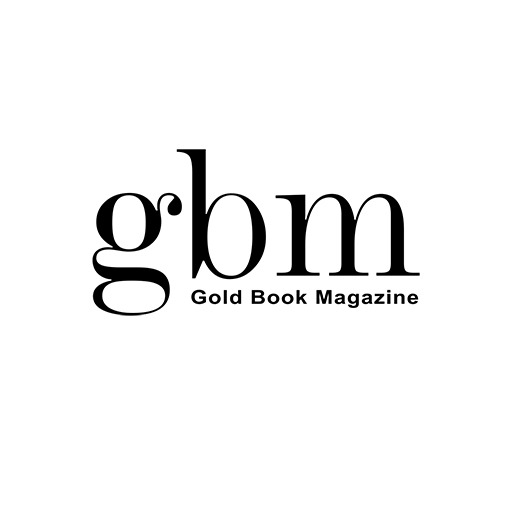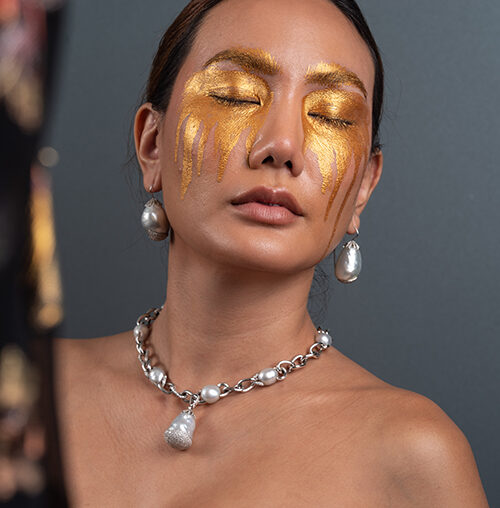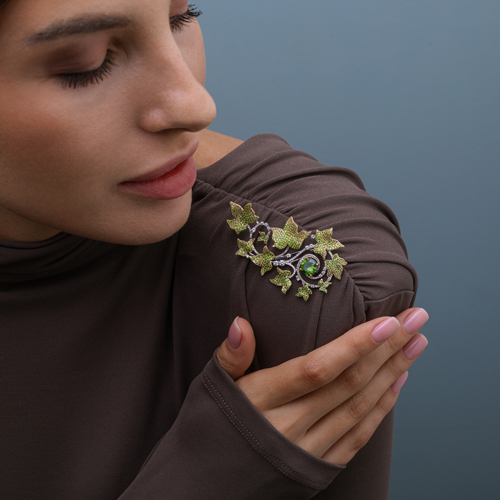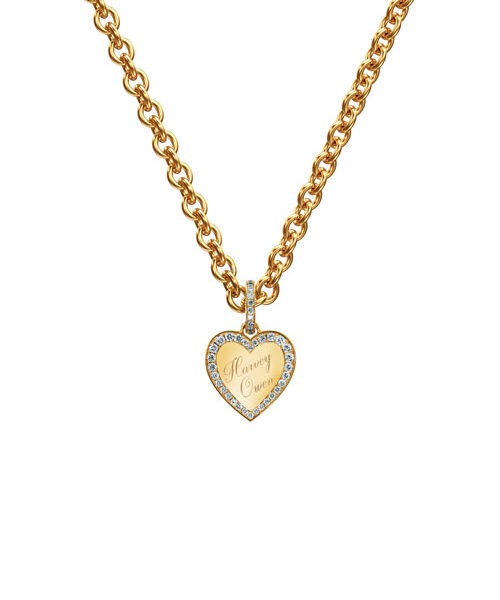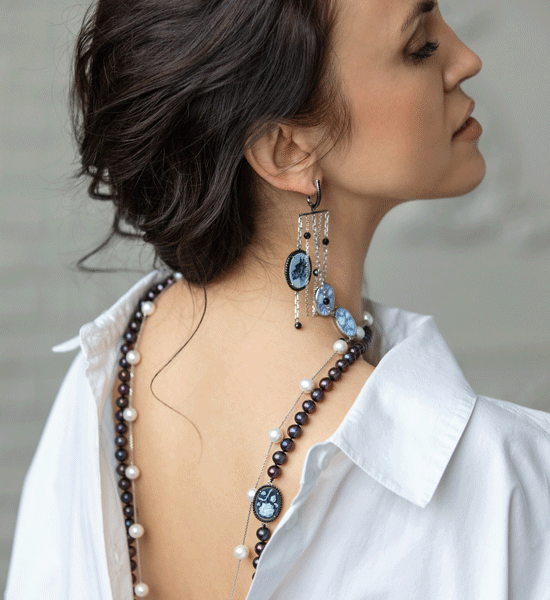
ZEYNEP ELBEYLİ
‘I AM A DESIGNER WHO INTENDS TO BRING OUR RICH CULTURAL HERITAGE TOGETHER WITH MODERN DESIGN AND INTRODUCE IT ONCE MORE IN OUR LIVES’
Let us get to know Zeynep Elbeyli. Can you talk a little bit about yourself?
I am a ‘trash’ artist, who have shifted her focus of attention to objects, which had been directed to the rehabilitation of patients for 25 years upon getting a degree from Hacettepe University; at the same time, I am a designer who intends to bring our rich cultural heritage together with modern design and introduce it once more in our lives. I am making original and custom items (accessories-lighting fixtures).
In a way, you utilize trash (discarded items), give them different forms and introduce them to the lives of others. As far as we know, TRASHINE is your brand identity. How did this creative process come to life? Why trash art?
I see our efforts to preserve nature as an intrinsic fundamental duty that precedes all of our other identities. That is because we (humans) are the only ones to corrupt it. As people, we produce more than we can consume for the sake of money. This way, as we clean out the world’s resources, we also keep adding on the piles of garbage, only to feed what threatens our future on this planet two ways. Each one of us should burn a candle to light this world that we keep turning into a wasteyard. My way of doing this is through art, that is because it is the most naïve way of self-expression, and rebellion, even. My designs, which are called SAN/AT/IK Aydinlik (Trash Art Illumination) usually come to life as statues and paintings which carry some light. I crave an intellectual awakening through the light I use metaphorically. It makes me really happy to read the notes on my exhibition book, showing me that the awareness I aim to raise is improving. “TRA SH INE” is my brand’s international official name and it is ready to continue its journey.
How did you take up an interest in Jewellery design?
Designing jewelry goes far back for me. I have been making my own accessories since I was a child unfortunately but could not wear them since they were unorthodox. Now that the people became aware of their ‘’uniqueness,’’ they find a design which is as unique as they are more meaningful and prefer them. Which serves my purpose, actually. In addition, I think I feel like I have another chance at confronting the community pressure I faced during my youth.
What kind of designs are they?
My work has many layers, I have been designing and producing free of commercial concerns up until now and I never keep an eye on fashion; I strive to implement creative ideas without thinking about whether they are going to sell. This really frees the design and the designer. However, doing what has never done before requires long processes to determine the problems which will occur throughout the time and finding solutions for them, which are beyond providing technical solutions only. When I fail to find the answers to my problems in the seeable future, sometimes I take my time to do experimental work by means of doing extended follow-ups. From time to time, I keep the design waiting, thinking ‘this is not it,’ whereas it may as well be ‘it’ and would sell. However, if money is not a priority, you treat the accessory as a piece of art. In this case, it takes four years to launch a line of bowties such as it was with ‘Bir Sevdadir Anadolu.’ (A Longing That is Anatolia)Çok katmanlı işlere imza atıyorum ben; şu ana kadar ticari kaygıdan uzak tasarım ve üretim yaptım, trendleri hiç takip etmem, ne satar diye düşünmeden sadece kreatif fikirleri uygulamaya çalışıyorum. Bu tasarım ve tasarımcıyı çok da özgür kılan bir şey aslında. Ancak yapılmamışı yapmak, teknik çözümlerin ötesinde zamansal düzlemde doğacak sıkıntıların tespiti ve çözümleri için uzun süreçler gerektiriyor. Beni bekleyen sorunların yanıtını kimseden alamayınca bazen uzun süreçli takiplerle deneysel çalışmalar yaparak ilerliyorum, bazen de içime sinmediği için “hayır, bu değil” diyerek tasarımı bekletiyorum; oysa o haliyle bitse belki daha bile çok satacak. Ama öncelik para olmayınca aksesuarda da bir sanat eseri gibi ilerliyorsunuz. Böyle olunca “Bir Sevdadır Anadolu” gibi, bir papyon serisinin çıkması dört seneyi bulabiliyor.
You exhibited your line of bowties in the Middle East Jewelry Fair. It attracted a great deal of attention from our side as well. Can you talk about the story behind?
I wanted to create a modern design which has a strong back story by combining the mosaic patterns of the Zeugma Ancient City, which is reminiscent of the 2nd-3rd centuries BC and continues to evoke admiration still, with the copper embroidery and ‘kutnu’ fabric of Gaziantep city, which goes back to the 16th century (both hand work). I think it is an important and creative design in terms of keeping these three cultural values alive and introducing them to the world. The story of ‘Bir Sevdadir Anadolu’ goes back to 2014. It took me 4 years to overcome the technical problems and production issues which I have mentioned before. When I finished my design in my mind, it was being publicized that Nuri Bilge Ceylan’s ‘Ahlat Agaci’ (The Wild Pear Tree) was nominated for Oscars. It excited me quite a deal. As a person who is very fond of her homeland, I pictured this enlightened personage of our country at the Oscars with the statue in his hand and ‘Bir Sevdadir Anadolu’ surrounding his neck with kindness. The name of the series was inspired as such; furthermore, I sent the first bowtie which was designed with my favorite pattern to Mr. Ceylan through the agency of his assistant with a letter.

Why choose the bowtie?
I like bowties, I think it is a special accessory which communicates excellence. Lately, its design and production for women became diversified in particular, on the other hand, I do not observe the same improvement and novelty for men’s wear and accessories, however, it is unknown to me whether this is related to the demand.
I think bowtie is the most special accessory for a modern and selected men, I work with cufflinks as well, however, I resemble the bowtie to a man’s ‘solitaire ring.’ I make custom designs for grooms. For example, this year, I prepared a bowtie line which I called ‘Gazilerin Bulusmasi’ (A Meeting Amongst the Veterans) in memoriam of the 100th year of our great leader Ataturk setting foot on Samsun to light the torch of hope. I brought the kutnu fabric which has become the symbol of Gaziantep with the relief and signature of Ghazi Ataturk.
I believe in something: feeling special is related to ‘ego’ and feeling unique to ‘self-confidence!’ I wanted a selected design for individuals who feel ‘special’ because they are ‘unique.’ Up until now, I produced all of my designs as unique as the nature’s presentation.
What nourishes you as a designer, what triggers your work?
I believe everything we need is in nature, it is already in there. I think art nourishes from nature as well as science, whereas science pursues unseen relations with a need for proof, art builds these relationships aesthetically through right brain perception. Of course, it takes observational skill to be a designer.
As we are talking about nature, would you like to talk about another line of yours, ‘Limonun Z hali’ (‘Z’, the final state of Lemon)?
It is always possible to see my worries, longings, messages relating to nature and people within my designs. The ‘Z’, which is the final state of Lemon was a line I put forth to highlight my respect for nature and the importance of its uniqueness. I wanted to stress that being unique is more important than being special, I wanted people to question themselves based on this idea, which they found to be interesting. Also, I wanted to show a woman’s power to transform; I wanted to show what a piece of garbage from the kitchen could turn into when you go through the trouble. And then, Z of Lemon was the first leg of a very extensive exhibition composed of organic pieces. I am dreaming of a Guinness record for this extensive exhibition.
How do you bring your designs to the ones who wish to have them, do you hold a sales channel?
The last ring of my design journey involves the education of undergraduate girls who do not smoke. Sales is important to keep this project going. The base for the scholarship was built on the custom designs I have made for private institutions and organizations, municipalities, universities, museum, etc. This far, I sold my items during my exhibitions, but people who want to have them can easily reach me through my contact information.

